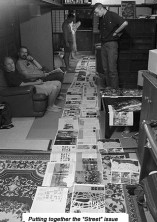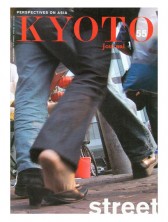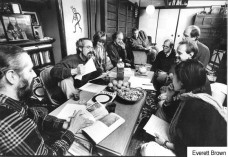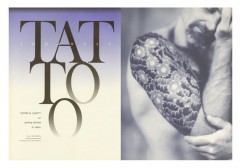December 1, 2005
Kyoto Journal Inspired
by Damon Shulenberger
The Kyoto Journal has always been a source of admiration and inspiration to editors, translators, and writers connected with Japan. In 2005, founding editor John Einarsen and associate editor Stewart Wachs spoke to a large SWET audience about their different perspectives on the journal’s making and showed a lively collection of slides of KJ covers and pages. They explained the secrets of keeping an all-volunteer quarterly journal coming out for nearly 20 years. In 2010, Kyoto Journal ceased publishing in print and set its sights on online publication. See their website for further information.
In November SWET welcomed John Einarsen and Stewart Wachs of Kyoto Journal. Einarsen is the magazine’s founding editor and art director; Wachs is associate editor. Together with managing editor Ken Rodgers and others who could not join them in Tokyo, they guide the editing and design of this magazine through four issues each year. Now in its nineteenth year of publication, Kyoto Journal, or "KJ" as it is affectionately known, provides a unique forum for literature, poetry, art, translation, and social and cultural commentary, not just from Kyoto, but from all of Asia. Today the magazine's professional, color-accented format and its subtitle, "Perspectives from Asia," belie its humble beginnings as a cut-and-paste, typeset, Kyoto-centric enterprise. Through this evolution KJ has nevertheless stayed true to its roots; the work of a host of dedicated volunteers, contributors included, this non-profit magazine remains foremost a labor of love—as Einarsen put it, "our heart work."
Foundations: Visionary and Monetary
Appropriately, Einarsen began the presentation by outlining KJ's beginnings in the early 1980s. Numerous people from overseas had made the old capital their home while they explored Japanese culture and their own creative impulses. Observing this phenomenon, Einarsen thought, "There should be an English magazine to share all this!" Although he had no experience in journalism, he had fallen into the role of editor for Kaleidoscope Kyoto, a magazine founded by Fujii Munemi. He was hopeful that the magazine would provide the cultural forum he had long dreamed of, but after only two years it foundered for want of funds, the fate of many small publications. Einarsen's vision, however, held firm. Writers with a wide range of interests were already gathering at his home once a month for a loosely organized literary event. (Some of them became founding staff members of KJ.) The Kyoto Connection, a monthly open-mike event of comedy, poetry, music, storytelling, and general mayhem that lasted for almost fifteen years, grew out of this same group of people under the guiding hand of Ken Rodgers.
In this milieu, only lack of financial backing prevented realization of the printed journal that Einarsen envisioned. He visited scores of prospective sponsors with his proposal, but met with one rejection after another. Undaunted, he and his cohorts set up a foundation, and began collecting money from supportive individuals. Then, only a week after undertaking this strategy of last resort, good fortune appeared in the person of Harada Shokei of the Heian Bunka Center. Einarsen still chuckles when he recounts his first meeting with Harada in 1986: how he dressed carefully in suit and tie for the encounter and how he waited nervously in an elegant anteroom, only to be greeted warmly by Harada in jeans and cowboy boots, hair down to his shoulders. After listening to Einarsen's presentation of his idea for a mere thirty minutes, the scion of a calligraphy school empire shook his hand, and the magazine had financial wings. Harada has been continuously "very understanding and generous," and nineteen, going on twenty years later, that handshake is still in effect.
The arrangement with Harada and the Heian Bunka Center proved to be naturally compatible. The Center is the textbook publishing arm of Nippon Shūji, a leading calligraphy school. Based in Kyoto, it has almost half a million correspondence-based students throughout the country. The founder of the school was Harada Shokei’s father, the legendary Harada Kampō, a master calligrapher who popularized his style of calligraphy throughout Japan. With a long white beard, the elder Harada cut a striking figure, giving calligraphy demonstrations around the world. While on these travels, he amassed a sizeable art collection from many cultures, much of which is on display at the museum named after him in Okazaki, Kyoto. The senior Harada’s philosophy was based on the value of "passing culture on" and this, he believed, could lead to world peace. "Passing culture on" continues to be a guiding principle of the Center today, and one of the reasons they decided to support Kyoto Journal. The KJ editors consider themselves blessed in having a sponsor who also believes in the value of artistic and cultural expression. The Heian Bunka Center pays the costs of printing and mailing the magazine, and KJ uses the school's mailing facility and a storage room at the Center.
In keeping with the affinity in philosophy and objectives with its backer, Kyoto Journal staff have enjoyed complete editorial freedom. Consultation with Harada has only been necessary on two occasions and his response was affirming in both cases. The first occurred in 1991 with the "Eros" theme issue that featured a set of erotic photos by Araki Nobuyoshi. The timing of publication happened to coincide with that of "100 Nudes," an issue of the magazine Taiyo, which had ignited a "legal firestorm" over the showing of pubic hair in magazines. Ultimately that case led to liberalization of the "sandpaper laws," but in the meantime Kyoto Journal’s printer refused to print the issue. After considerable scrambling, a small printer willing to do the job was found (and has been retained to this day) and the magazine hit the newsstands on schedule. The trouble did not stop there, however, as KJ's Japanese distributor unexpectedly recalled all copies of the magazine and refused to proceed with distribution unless Harada Shokei signed a document stating he would bear all legal expenses that might ensue from publication. Harada signed without hesitation.
Harada was consulted again in the early 1990s when controversy was flaring over the new Kyoto Hotel, which had taken advantage of a legal loophole to exceed the height limit set by the city government in the 1920s. In response, KJ created a cover image depicting the new hotel as the gravestone of the ancient capital. Many local temples posted signs at their entrances declaring Kyoto Hotel guests persona non grata, as the offensive building could be seen from some of their precincts, marring their borrowed-scenery traditions. Residents, fearing this was the beginning of the end for the Kyoto they knew and loved, were in uproar. Their worst fears were fortunately allayed, Einarsen reassured us, calling the bursting of the bubble economy "in some ways the best thing that ever happened to Kyoto." Harada again saw no reason to step in, leaving the editors free to make their own creative statement on the cover. They gratefully realized how valuable it is to have a sponsor who shares the core values of a publication.
Growing an Issue
The KJ staff includes three main editors, seven interns and over 30 contributing editors spread across Asia. Other volunteers, without whom Kyoto Journal could not be marketed and distributed, take care of mailings, subscriptions, promotion, file-keeping and the like. Much of the creative impetus for the magazine occurs at informal gatherings of some of this team at Einarsen’s house following each new publication. At these gatherings, in what he considers "the most productive part of the meeting," the group breaks into small groups to brainstorm ideas for future issues.
For many journal editors in SWET, the story of how issues of Kyoto Journal come into being is exciting and enviable, if not  necessarily duplicable. Most periodicals have an established grid and templates for various recurring features, and manuscripts that come in are edited to fit into that predetermined schema. In contrast, the layout and composition of KJ is created fresh for every issue in an artistic and organic way, each as distinctive as a book, except for the logo title on the cover, the A4 size, and the average number of pages. Connecting themes often emerge only gradually, through a kind of serendipity.
necessarily duplicable. Most periodicals have an established grid and templates for various recurring features, and manuscripts that come in are edited to fit into that predetermined schema. In contrast, the layout and composition of KJ is created fresh for every issue in an artistic and organic way, each as distinctive as a book, except for the logo title on the cover, the A4 size, and the average number of pages. Connecting themes often emerge only gradually, through a kind of serendipity.
 "The magazine is a participant in its own creation," said Einarsen. Too much efficiency and a neat template would prevent this from happening, and the team prefers, he said, to leave "room for a little messiness." KJ’s quarterly publication schedule is one factor that allows for this. The editors work on several issues at once, drawing up plans and ideas for later issues while polishing another. They are not reluctant to set aside a piece they really like but that doesn't fit into an issue currently being worked on, holding it over until a suitable combination of articles comes together. As an example, Wachs mentioned a piece on Iran which they all felt would be extremely valuable, but had no related articles to provide additional context. Later, a longtime contributor who had spent time in Iran was passing through Kyoto, and he asked her to write a complementary piece; she generously agreed, and "completed it at a cafe in Cambodia," thereby expanding upon the original "kernel."
"The magazine is a participant in its own creation," said Einarsen. Too much efficiency and a neat template would prevent this from happening, and the team prefers, he said, to leave "room for a little messiness." KJ’s quarterly publication schedule is one factor that allows for this. The editors work on several issues at once, drawing up plans and ideas for later issues while polishing another. They are not reluctant to set aside a piece they really like but that doesn't fit into an issue currently being worked on, holding it over until a suitable combination of articles comes together. As an example, Wachs mentioned a piece on Iran which they all felt would be extremely valuable, but had no related articles to provide additional context. Later, a longtime contributor who had spent time in Iran was passing through Kyoto, and he asked her to write a complementary piece; she generously agreed, and "completed it at a cafe in Cambodia," thereby expanding upon the original "kernel."
Another example of serendipity occurred when Wachs was at a party with a number of translators and met a woman named Shinji Kazue, who mentioned that she had been a interpreter at a Kyoto psychotherapy clinic for twenty years, serving American clinicians and their Japanese clients (and vice versa). Wachs immediately recognized that she was a person who must have extraordinary cross-cultural insights and illuminating anecdotes, and he quickly arranged a time for an interview that subsequently saw print.
Secrets of Longevity
Wachs said he has found that the longevity of the magazine and long-term relationships with its contributors has created "a kind of snowball effect" in terms of the diversity and quality of unsolicited material they receive. At the same time, the fact that contributors receive no payment for their work has "weeded out" those who don't share the same commitment to the magazine's ethos. One criticism of Kyoto Journal is that it has sometimes been too "dense," Einarsen admitted, particularly with regard to earlier issues. As a quarterly publication, however, and considering the large number of submissions they receive, the editors feel obligated to include as much high quality writing as possible in each issue. Einarsen commented that "as an art editor I like white space, and I hate to see the white space always get gobbled up by gray text, but at the same time we need to get these people's work in KJ’s pages."
 Wachs explained that he and the other primary text editor, Ken Rodgers, often divvy up assignments based on previous working relationships with the writer and other natural connections or proclivities. If a piece needs heavy editing or revising, it often goes to Rodgers first because he has "an amazing ability to see substructures" in pieces, knowing how to bring to fruition writing that others might give up on. If micro-editing is needed—for style, bridges between parts, openings or closings—it tends to come to Wachs. He likened their teamwork to that of translation partners. Often there is intuitive communication between them about a piece: one cleans up an area without even knowing the other had concern with it. "It's a dance, and it's really nice," said Wachs.
Wachs explained that he and the other primary text editor, Ken Rodgers, often divvy up assignments based on previous working relationships with the writer and other natural connections or proclivities. If a piece needs heavy editing or revising, it often goes to Rodgers first because he has "an amazing ability to see substructures" in pieces, knowing how to bring to fruition writing that others might give up on. If micro-editing is needed—for style, bridges between parts, openings or closings—it tends to come to Wachs. He likened their teamwork to that of translation partners. Often there is intuitive communication between them about a piece: one cleans up an area without even knowing the other had concern with it. "It's a dance, and it's really nice," said Wachs.
They see themselves as intermediaries, “ "helping writers to bring out their ideas in the fullest sense, while at the same time assisting readers by trying to make those ideas as fully and clearly accessible as possible." This requires such humdrum tasks as multiple fact-checking (utilizing the Internet with care) as well as the more subtle crafting of "mutually beneficial" relationships with writers. And while they have posted style guidelines on the website, "there is no one KJ voice," the goal being to nurture the individual voice of each KJ writer. Generally, there is little concern over getting credit for editing a piece, and liberal amounts of compromise and a modicum of stubbornness seem to be the recipe for a dynamic and harmonious working relationship.
The KJ editors noted that they consciously try not to get "crazy busy" with the magazine. This has been a hard-earned ideal, since the number of things one can do on a magazine is "endless." Today they make a concerted effort to balance their lives among regular job, family, and the magazine. Wachs described Einarsen as a model in putting this principle into practice, waking around 5:30 a.m. and spending a couple of hours on the Journal. This frees up the rest of the day for non-KJ-related activities and largely hides his work from the family, joked Wachs, who often does KJ work in the evening, missing out on "the family stuff" going on in the living room while he is absorbed in email and editing. He is, however, striving to emulate Einarsen’s "non-crazy busy" style.
The editors at KJ view the developing of new writers and artists as one of the core missions of their enterprise. Wachs noted that a fair amount of editorial work goes into even articles that don't actually get printed. The consideration process may involve numerous email exchanges, light editing, and much editorial contemplation, and Rodgers does not hesitate to write long and thoughtful letters to contributors, even when the response is a rejection. While this may seem an inefficient way of going about things, Wachs said that even authors whose work has been rejected often come back later with other, more successful contributions, so in the long run the KJ community is enriched.
Maintaining balance in the content of a magazine is a concern of many editors, both in terms of subject matter and kinds of contributors. The KJ editors have noted that women contributors seem to be chronically in the minority in their pages. Although the current issue has over twelve contributions by women, "this is difficult to sustain," said Wachs. "Generally, and for some reason we don't fully understand yet, male writers approach us more assertively than female writers."
 Geographic and Psychographic Scope
Geographic and Psychographic Scope
From its beginnings in Kyoto, with its focus primarily on Japanese-related issues, the Journal has grown to embrace all of Asia, from Japan to Turkey, as its potential subject matter. Inevitably there have been many discussions about changing its name, but no better idea has come forth. Kyoto as the magazine's place of origin, as its ongoing geographic base, and as a vital cultural crossroads, secures its name in the title, at least for the time being.
On the other hand, the KJ community has changed with the years, in often profound ways. Wachs is excited and intrigued by its shift in focus from the environs of Kyoto to a " psychographic" community, due in large part to the Internet. All of the collaborators use email and the Internet to extend and enliven the KJ community, with results that have made the magazine' s pages richer than ever. While putting together one special issue in 1999—Media in Asia—Wachs collected a cache of some 3000 emails exchanged with contributors in ten months. The Internet has proved an invaluable resource for keeping in touch with disparate writers, often travelers who might well have decamped from one country to another between messages. KJ editors have traveled to meet contributors in Bangkok, Seoul, Beijing, London, Boston, and Los Angeles, "just to name a few," but keep up with them otherwise from their desktops in Kyoto.
Kyoto Journal has a website that features back issues, selected articles, and KJ news. Wachs pointed out that articles in the print magazine are not available online, though online articles are often listed in the print magazine’s contents page. The website generates an average of 24,000 hits a month. "KJ news" is a relatively new section of the site featuring information on KJ-related events, and incidentally, according to Einarsen, "perhaps the only photos of the recent demonstrations against Bush in Kyoto you’ll find anywhere."
The print run per issue is now 6,000, and while distribution is concentrated in Japan and North America, there are subscribers in at least 20 countries around the world. The major post-production headache for the KJ staff is distribution. Wachs explained that, as magazine distributors have merged and become ever more streamlined, they have become increasingly reluctant to deal with smaller publications such as KJ, which are of only marginal profit to them. He and his fellow staff have, "at their own peril," resisted pressure from their North American distributor to include listings of the articles on each and every cover, a tactic that supposedly has a beneficial effect on newsstand sales. He noted, however, that the best-selling issue had a cover photograph of a geisha, with hardly any descriptive text whatsoever.
Unique Publishing Niche
Every journal wants to find its own niche in order to make its mark in the deluge of information available today, and Kyoto Journal editors pride themselves on providing an avenue for publication of articles that may be fascinating, but hard to publish elsewhere. As an example Wachs mentioned an article that will appear in the next issue of KJ on the untold story of the relationship between "the cartoonist Charles Schultz of Peanuts fame and the poet Tanikawa Shuntarō." Another example from a past issue is a Noh play written in English, Return to Kanburi, based on a true story of the eventual reconciliation between a brutalized allied prisoner of war and his Japanese interrogator.
A relatively new feature called "In Translation" seeks to broaden Kyoto Journal's scope by publishing Asian writers' works in translation in addition to occasional articles exploring the often misunderstood art of translation itself. Numerous translated stories and articles involving writers such as Murakami Ryū, interviews with various translators, and the like preceded inauguration of the actual section "In Translation," primarily the brainchild of Ken Rodgers. In the next issue this section will feature a translation of Fujisawa Shūhei's short story, “Cloudburst” (Hashiri ame) by Gary Alderson, a long-time technical translator, who was inspired to try his hand at literature for the 5th annual Shizuoka International Translation Competition. Wachs noted that Fujisawa has "sold something like 23 million copies of his book in Japan . . . but you go to Amazon.com and until now, there was not a single translated book by Fujisawa." In this way Wachs hopes that "In Translation," which he oversees, can in some small way fill the enormous gap in translated works by Asian writers and make Kyoto Journal readers aware of some of the worthwhile authors—and translators—that exist. (Note: In December, Kodansha International published The Bamboo Sword and Other Samurai Tales, short stories by Fujisawa Shūhei, published with support from the Japanese Literature Promotion and Publishing Program; translation by SWET member Gavin Frew; Hashiri ame is among the stories in this anthology as well).
Prerequisites for publication in KJ include sincerity in the writer and the feeling among the editors after reading a piece that their perspectives have been enlarged or somehow illuminated. Submissions must have some clear connection with Asia, and while KJ's editors respect academic research and depth of content, they stress that writers should speak to a non-specialist readership. As the KJ website's submission guidelines put it, "We are especially interested in local voices, from all over Asia. We seek ideas that illuminate cultural differences in a positive way, that promote intercultural understanding via specifics, not generalities." Since the magazine is a quarterly, articles must have shelf-life.
John Einarsen, as the publication's main designer, melds text and graphics to enhance content, picking up on subtle resonances between different articles and giving KJ its very distinctive visual character. Kyoto Journal won the Utne Reader's prestigious Independent Press Award for Excellence in Art & Design in 1998, and the magazine has been short-listed in diverse IPA categories (including Writing Excellence, Design Excellence, General Excellence, Best Essays, Regional/Cultural Coverage, and International Coverage) for each of the past nine years. The editors have also been asked to nominate published KJ pieces for the Pushcart Prize in the last two years. The SWET community joins in recognizing this excellence and thanks the Kyoto Journal community for setting the bar so high in (independent) English-publishing within Japan.
The two-hour event, enlivened by the striking images from the journal projected on the screen in the lecture room, ended before discussion could begin. The group moved to another room to continue with questions and answers from the speakers, who generously added further information from their experience and perspective. Several members of the SWET Newsletter editorial team present at the event were greatly encouraged and invigorated by their talk, which offered much inspiration to draw from.
Photos reproduced by kind permission of Kyoto Journal.
Originally published in the SWET Newsletter No. 110 (December 2005).
